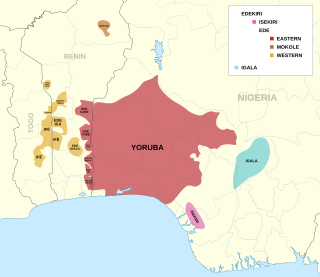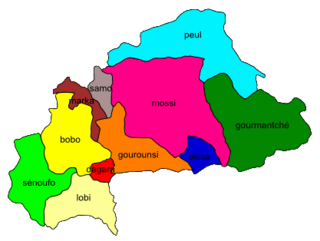Related Research Articles

Hausa is a Chadic language that is spoken by the Hausa people in the northern parts of Nigeria, Ghana, Cameroon, Benin and Togo, and the southern parts of Niger, and Chad, with significant minorities in Ivory Coast. A small number of speakers also exist in Sudan.
The Central Tano or Akan languages are languages of the Niger-Congo family spoken in Ghana and Ivory Coast by the Akan people.
The Dangme language, also Adangme, Dangbe or Adaŋgbi, is a Kwa language spoken in south-eastern Ghana by the Dangme people (Dangmeli). They are part of the larger Ga-Dangme ethnic group. Klogbi is a variant, spoken by the Kloli. Kropp Dakubu (1987) is the most thorough grammar of the language.

Akan is the largest language of Ghana, and the principal native language of the Akan people, spoken over much of the southern half of Ghana. About 80% of Ghana's population speak Akan as a first or second language, and about 44% of Ghanaians are native speakers. Akan is also spoken across the border in parts of Côte d'Ivoire.
Khams Tibetan is the Tibetic language used by the majority of the people in Kham. Khams is one of the three branches of the traditional classification of Tibetic languages. In terms of mutual intelligibility, Khams could communicate at a basic level with the Ü-Tsang branch.

Fante, also known as Fanti, Fantse, or Mfantse, is one of the three literary dialects of the Akan language, along with Asante and Akuapem, with which it is mutually intelligible. It is principally spoken in the central and southern regions of Ghana as well as in settlements in other regions in western Ghana, Ivory Coast, as well as in Liberia, Gambia and Angola.

Yoruboid is a language family composed of the Igala group of dialects spoken in south central Nigeria, and the Edekiri group spoken in a band across Togo, Ghana, Benin and southern Nigeria, including the Itsekiri of Warri Kingdom.

Ghana is a multilingual country in which about eighty languages are spoken. Of these, English, which was inherited from the colonial era, is the official language and lingua franca. Of the languages indigenous to Ghana, Akan is the most widely spoken in the south. Dagbani, Dagare, Sisaala, Waale, and Gonja are among the most widely spoken in the northern part of the country.
Anyin, also known as Agni, Agny, and Anyi, is a Niger-Congo language spoken mainly in Côte d'Ivoire and Ghana. It is a Kwa language of the Central Tano branch, forming a dialect continuum with Baoulé, and is closely related to Nzema and Sehwi. Its dialects, divided into Northern and Central dialect areas, include Sannvin, Abé, Ano, Bona, Bini, and Barabo in the Northern area and Ndenye and Juablin in the Central area. In Côte d'Ivoire, there are approximately 1.45 million native speakers of Anyin, along with 10,000 second-language users; in Ghana, there are approximately 66,400 speakers.
Nzema, also known as Nzima or Appolo, is a Central Tano language spoken by the Nzema people of southwestern Ghana and southeastern Ivory Coast. It is partially intelligible with Jwira-Pepesa and is closely related to Baoulé.
Bono, also known as Abron, Brong, and Bono Twi, is a major dialect within the Akan dialect continuum that is spoken by the Bono people. Bono is spoken by approximately 1.2 million people in Ghana, primarily in the Bono Region, Bono East Region, and by over 300,000 in eastern Côte d'Ivoire.

Bissa, is a Mande ethnic group of south-central Burkina Faso, northeastern Ghana and the northernmost tip of Togo. Their language, Bissa, is a Mande language that is related to, but not the same as, a cluster of languages in the old Borgu Kingdom area of Northeast Benin and Northwest Nigeria, including Busa, Boko, and Kyenga. An alternate name for the Bissa is Busansi which is used by the Mossi people and Kusasi people or Busanga.
The Sefwi are an Akan people.
Twi is the common name of the literary dialects of the Akan language of Asante and Akuapem, but excluding Fante. It is not a linguistic grouping, as Akuapem is closer to Fante than it is to Asante. Twi generally subsumes the following Akan dialects: Ahafo, Akuapem, Akyem, Asante, Asen, Dankyira and Kwawu, which have about 4.4 million speakers in southern and central Ghana.

Kulango is a Niger–Congo language spoken in Ivory Coast and across the border in Ghana. It is one of the Kulango languages, and it may be classified as a Gur language. There are two principal varieties distinct enough to be considered separate languages: the Kulango of Bondoukou (Bonduku), also known as Goutougo locally, and that of Bouna (Buna). Ethnologue reports that Bouna-dialect speakers understand Bondoukou, but not the reverse. Bouna, in addition, has the subdialects Sekwa and Nabanj. In Ghana, the principal towns in which the language is spoken are Badu and Seikwa, both in the Tain District, and Buni in the Jaman North district, all in the Bono region of Ghana. In addition, there are smaller towns and villages closer to Wenchi in the Bono region and Techiman in the Bono East region where this language is spoken. Among these are Asubingya (Asubinja) and Nkonsia. The Koulango are matrilineal like the Akans and possess similar cultural practices.
The Anii is a Guan language is spoken in Benin, and central-eastern Togo and central eastern Ghana by Makכ-Makua or Bakכ-Bakua clan. It is part of the geographic group of Ghana Togo Mountain languages of the Kwa branch of Niger–Congo.
The Mampruli language is a Gur language spoken in northern Ghana, Northern Togo, Burkina Faso, Ivory Coast and Mali by the Mamprusi people. It is partially mutually intelligible with Dagbani. The Mamprusi language is spoken in a broad belt across the northern parts of the Northern Region of Ghana, stretching west to east from Yizeesi to Nakpanduri and centred on the towns of Gambaga, Nalerigu and Walewale.
Sefwi or Sehwi may refer to:
Jwira–Pepesa, also known as Gwira and Pepesa–Jwira, is a Niger-Congo language of the Western Region of Ghana, consisting of the mutually intelligible dialects Jwira and Pepesa, with approximately 18,000 speakers total. It is a Kwa language of the Central Tano branch, and shares 60% intelligibility with Nzema and partial intelligibility with Ahanta and Anyin. Jwira is spoken in 18 villages from Bamiankaw to Humjibere along the Ankobra River, while Pepesa is spoken on Wasa land between Agona Junction and Tarkwa. The two dialects are separated by a mountain range.
Florence Abena Dolphyne is a Ghanaian linguist and academic. She was the first female professor and first female pro-vice chancellor of the University of Ghana.
References
- ↑ Sefwi at Ethnologue (22nd ed., 2019)

- ↑ "Sehwi". Ethnologue. Retrieved 2020-01-04.
- ↑ Broohm, Obed Nii (2017-01-01). "Broohm: Noun Classification in Esahie". Ghana Journal of Linguistics. 6 (3): 81–122–122. doi: 10.4314/gjl.v6i3.4 . ISSN 2026-6596.
- 1 2 "A summary report on the sociolinguistic survey of the Sehwi language". SIL International. 2013-01-28. Retrieved 2020-01-04.
- ↑ Dolphyne, Florence Abena (1986) The languages of the Akan peoples. Research review. Vol. 2 No. 1, Pages 1-22 University of Ghana.